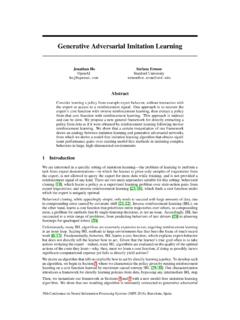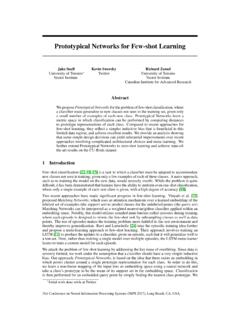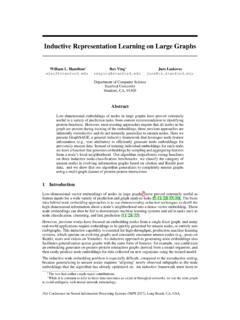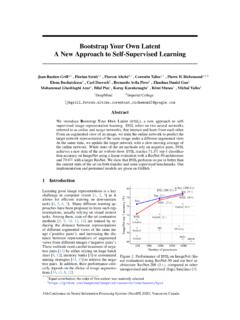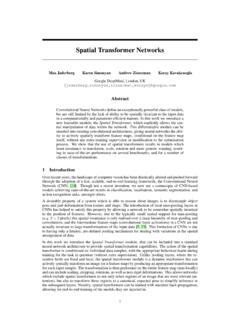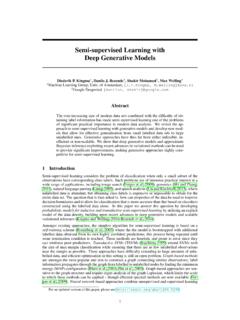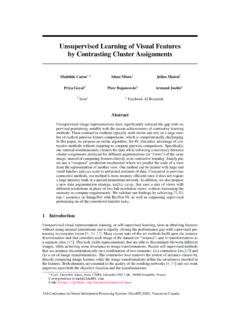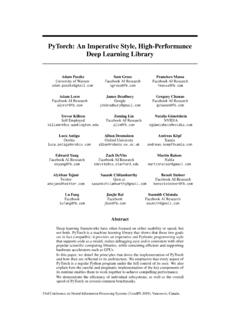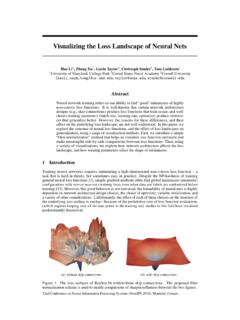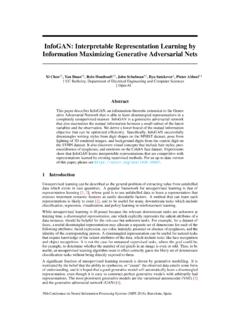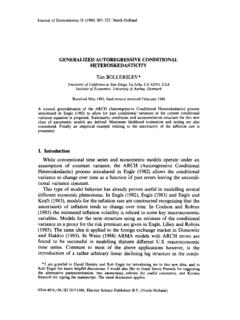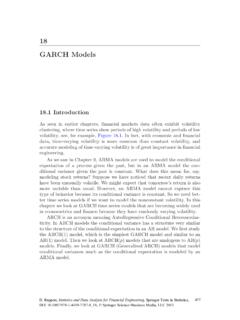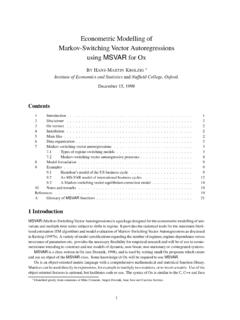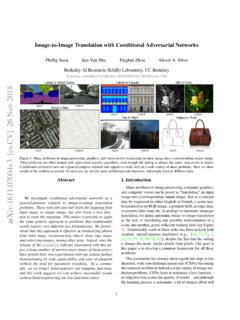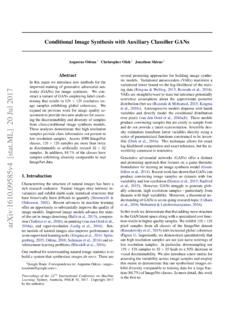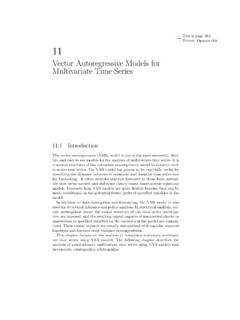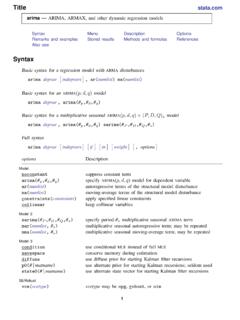Transcription of XLNet: Generalized Autoregressive Pretraining for Language ...
1 xlnet : Generalized Autoregressive Pretrainingfor Language UnderstandingZhilin Yang 1, Zihang Dai 12, Yiming Yang1, Jaime Carbonell1,Ruslan Salakhutdinov1, Quoc V. Le21 Carnegie Mellon University,2 Google AI Brain the capability of modeling bidirectional contexts, denoising autoencodingbased Pretraining like BERT achieves better performance than Pretraining ap-proaches based on Autoregressive Language modeling. However, relying on corrupt-ing the input with masks, BERT neglects dependency between the masked positionsand suffers from a pretrain-finetune discrepancy. In light of these pros and cons, wepropose xlnet , a Generalized Autoregressive Pretraining method that (1) enableslearning bidirectional contexts by maximizing the expected likelihood over allpermutations of the factorization order and (2) overcomes the limitations of BERT thanks to its Autoregressive formulation.
2 Furthermore, xlnet integrates ideasfrom Transformer-XL, the state-of-the-art Autoregressive model, into , under comparable experiment setting, xlnet outperforms BERT on20 tasks, often by a large margin, including question answering, natural languageinference, sentiment analysis, and document IntroductionUnsupervised representation learning has been highly successful in the domain of natural languageprocessing [7,22,27,28,10]. Typically, these methods first pretrain neural networks on large-scaleunlabeled text corpora, and then finetune the models or representations on downstream tasks. Underthis shared high-level idea, different unsupervised Pretraining objectives have been explored inliterature.
3 Among them, Autoregressive (AR) Language modeling and autoencoding (AE) have beenthe two most successful Pretraining Language modeling seeks to estimate the probability distribution of a text corpus with an au-toregressive model [7,27,28]. Specifically, given a text sequencex= (x1, ,xT), AR languagemodeling factorizes the likelihood into a forward productp(x) = Tt=1p(xt|x<t)or a backwardonep(x) = 1t=Tp(xt|x>t). A parametric model ( a neural network) is trained to model eachconditional distribution. Since an AR Language model is only trained to encode a uni-directional con-text (either forward or backward), it is not effective at modeling deep bidirectional contexts.
4 On thecontrary, downstream Language understanding tasks often require bidirectional context results in a gap between AR Language modeling and effective comparison, AE based Pretraining does not perform explicit density estimation but instead aims toreconstruct the original data from corrupted input. A notable example is BERT [10], which has beenthe state-of-the-art Pretraining approach. Given the input token sequence, a certain portion of tokensare replaced by a special symbol[MASK], and the model is trained to recover the original tokens fromthe corrupted version. Since density estimation is not part of the objective, BERT is allowed to utilize Equal contribution.
5 Order determined by swapping the one in [9].1 Pretrained models and code are available Conference on Neural Information Processing Systems (NeurIPS 2019), Vancouver, contexts for reconstruction. As an immediate benefit, this closes the aforementionedbidirectional information gap in AR Language modeling, leading to improved performance. However,the artificial symbols like[MASK]used by BERT during Pretraining are absent from real data atfinetuning time, resulting in a pretrain-finetune discrepancy. Moreover, since the predicted tokens aremasked in the input, BERT is not able to model the joint probability using the product rule as in ARlanguage modeling.
6 In other words, BERT assumes the predicted tokens are independent of eachother given the unmasked tokens, which is oversimplified as high-order, long-range dependency isprevalent in natural Language [9].Faced with the pros and cons of existing Language Pretraining objectives, in this work, we proposeXLNet, a Generalized Autoregressive method that leverages the best of both AR Language modelingand AE while avoiding their limitations. Firstly, instead of using a fixed forward or backward factorization order as in conventional AR mod-els, xlnet maximizes the expected log likelihood of a sequence possible permutationsof the factorization order.
7 Thanks to the permutation operation, the context for each position canconsist of tokens from both left and right. In expectation, each position learns to utilize contextualinformation from all positions, , capturing bidirectional context. Secondly, as a Generalized AR Language model, xlnet does not rely on data corruption. Hence, xlnet does not suffer from the pretrain-finetune discrepancy that BERT is subject to. Meanwhile,the Autoregressive objective also provides a natural way to use the product rule for factorizing thejoint probability of the predicted tokens, eliminating the independence assumption made in addition to a novel Pretraining objective, xlnet improves architectural designs for Pretraining .
8 Inspired by the latest advancements in AR Language modeling, xlnet integrates the segmentrecurrence mechanism and relative encoding scheme of Transformer-XL [9] into Pretraining , whichempirically improves the performance especially for tasks involving a longer text sequence. Naively applying a Transformer(-XL) architecture to permutation-based Language modeling doesnot work because the factorization order is arbitrary and the target is ambiguous. As a solution, wepropose to reparameterize the Transformer(-XL) network to remove the , under comparable experiment setting, xlnet consistently outperforms BERT [10] on awide spectrum of problems including GLUE Language understanding tasks, reading comprehensiontasks like SQuAD and RACE, text classification tasks such as Yelp and IMDB, and the ClueWeb09-Bdocument ranking WorkThe idea of permutation-based AR modeling has been explored in [32,12], but thereare several key differences.
9 Firstly, previous models aim to improve density estimation by bakingan orderless inductive bias into the model while xlnet is motivated by enabling AR languagemodels to learn bidirectional contexts. Technically, to construct a valid target-aware predictiondistribution, xlnet incorporates the target position into the hidden state via two-stream attentionwhile previous permutation-based AR models relied on implicit position awareness inherent to theirMLP architectures. Finally, for both orderless NADE and xlnet , we would like to emphasize that orderless does not mean that the input sequence can be randomly permuted but that the modelallows for different factorization orders of the related idea is to perform Autoregressive denoising in the context of text generation [11],which only considers a fixed order Proposed BackgroundIn this section, we first review and compare the conventional AR Language modeling and BERT forlanguage Pretraining .
10 Given a text sequencex= [x1, ,xT], AR Language modeling performspretraining by maximizing the likelihood under the forward Autoregressive factorization:max logp (x) =T t=1logp (xt|x<t) =T t=1logexp(h (x1:t 1)>e(xt)) x exp (h (x1:t 1)>e(x )),(1)2whereh (x1:t 1)is a context representation produced by neural models, such as RNNs or Transform-ers, ande(x)denotes the embedding ofx. In comparison, BERT is based on denoising , for a text sequencex, BERT first constructs a corrupted version xby randomly settinga portion ( 15%) of tokens inxto a special symbol[MASK]. Let the masked tokens be x. Thetraining objective is to reconstruct xfrom x:max logp ( x| x) T t=1mtlogp (xt| x) =T t=1mtlogexp(H ( x)>te(xt)) x exp(H ( x)>te(x )),(2)wheremt= 1indicatesxtis masked, andH is a Transformer that maps a length-Ttext sequencexinto a sequence of hidden vectorsH (x) = [H (x)1,H (x)2, ,H (x)T].
